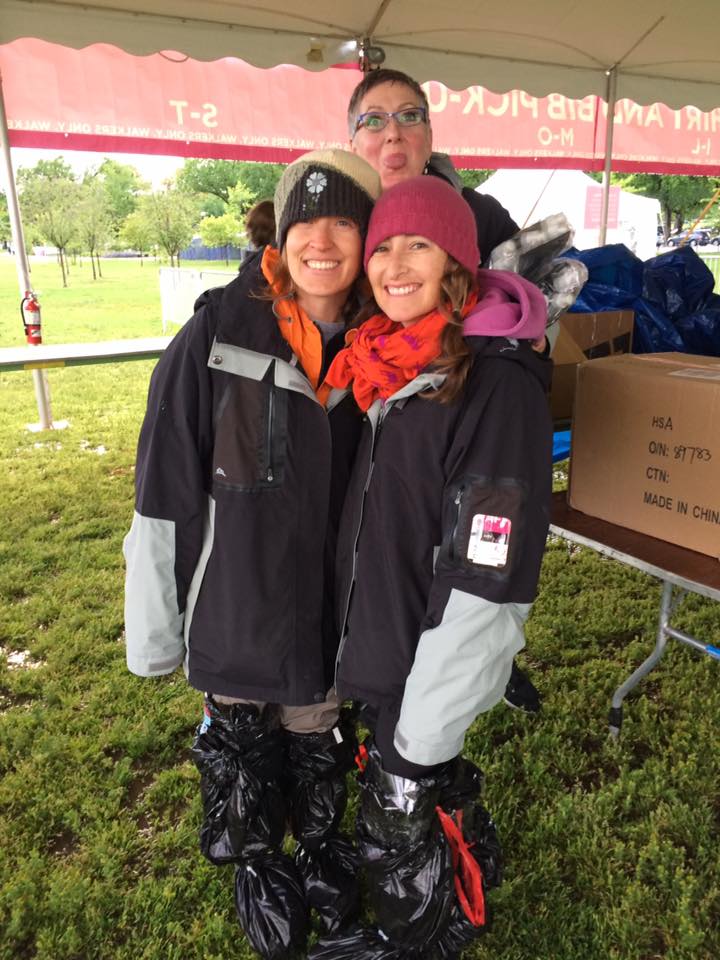January may still be a little bit early in the year to start your official 3-Day training, but if you’re eager to get started training your body to be able to walk 60 miles this summer, let’s chat about walking when the weather is not so pleasant. You may be wondering, “How can I get my 3-Day training walks in when it’s minus freezing degrees outside?”

All about those waterproof layers!
Here are some tips for walking in a winter wonderland:
Dress for the occasion – Before stepping outside, you’ll probably be inclined to bundle up in your down parka, but if you’re taking a walk, it may be better to dress in lighter, thinner layers, and shed as you go if you need to. Moisture-wicking fabric is best for the layer closest to your skin. You may be cold, but if you’re moving, you’re sweating, and the only thing worse than being really cold is being really cold and wet. Also, don’t forget hats and gloves, and whenever possible, wear bright colors and/or reflective materials so you stand out against your white-grey environment.

Look at how happy some of our 3-Dayers look in their gloves!
Warm your digits – One 3-Day coach loves those chemical-activated hand and foot warmers (available in the camping section of any sporting goods store). They are a quick, inexpensive way to keep your fingers and toes toasty. They fit snugly inside your gloves and your shoes and will ease the shock of the freezing temps on your extremities.
Take care of your skin – Cold air and wind can really do a number on exposed skin, so don’t forget to put on moisturizer before heading out. Sunscreen, too, is a must have for training any day of the week, any time of the year.

One of our coaches, Amy Schwager, stayed bundled in 2016
Hydrate – Drinking water when it’s hot out is a no brainer. You crave the cool water to quench the heat. It can be harder to remember to hydrate in the cold, but it’s no less essential when you’re exercising. If you normally carry your water in a fanny pack while you walk, think about holding it in your hand while walking in the cold, as an ever-present reminder to sip as you step.
Cool it on the mileage – There are many reasons why the 3-Day events take place in the late summer and fall, and it’s not just about walking those 60 miles in nicer weather; it’s also because we know that many of you superstar walkers can’t even really start training until the ground beneath you thaws out. But if you’re the type of go-getter who just can’t wait until the mercury rises, you can at least be comforted knowing that it’s okay to keep your walks short and sweet at this point. Once spring comes around and mother nature is a more agreeable training partner, then you can start upping the distance of your training walks.

Fun AND functional hats and scarfs
Choose your route carefully – Be certain that you’re walking someplace familiar, and be ready to pay close attention to the terrain with every step. If the sidewalks have not been cleared of ice and snow, walk in the street. (And on that note, make sure you’re wearing good shoes that have a little bit of traction on the sole.) Always tell someone where you’re going and when you expect to be back. If you get lost in a snow drift, they’ll want to know where to start digging!
Stay indoors – Wait, you’re not off the hook for training! But if it’s just too nasty outside, find someplace indoors to get moving. While we don’t recommend that you do all of your 3-Day training on a treadmill, it’s a perfectly good alternative to outdoor walking if you need it. No treadmill? Throw on your shoes and walk on an indoor track, through a shopping mall, or up and down the stairs in your office building. One of our coaches also suggested college campuses as places that often have large and/or interconnected buildings, and lovely grounds you can walk through.
Tell us your favorite cold weather walking tips!

Remember to always keep your socks dry!
REMINDER: The health, safety and training information contained in this blog post, or otherwise provided to you in connection with your participation in the 3-Day, is not intended to replace or be construed as medical advice and any such information is not a substitute for seeking medical advice or treatment from your medical provider. Before starting any exercise program or following any recommendations, advice or other instructions regarding training for the 3-Day or any athletic event, you should first consult a physician and have a physical examination.




